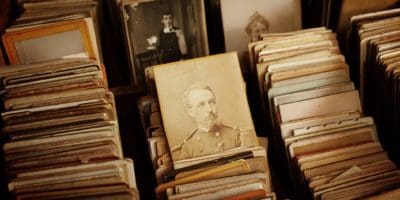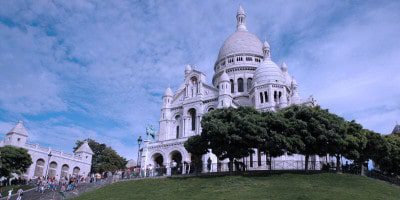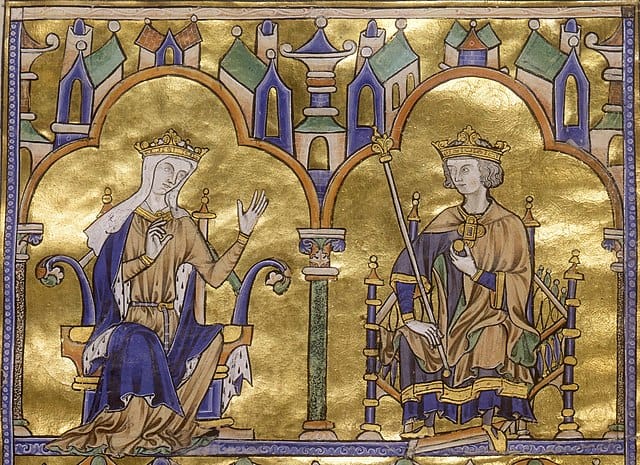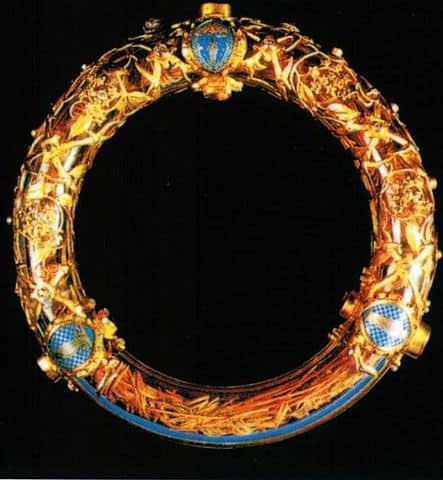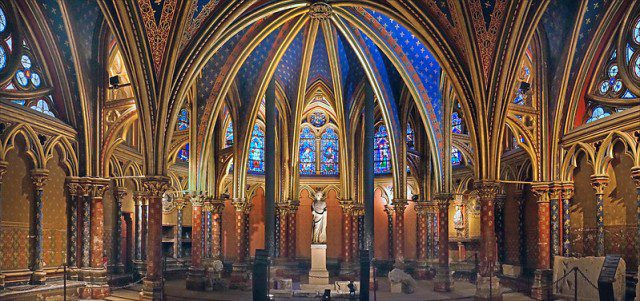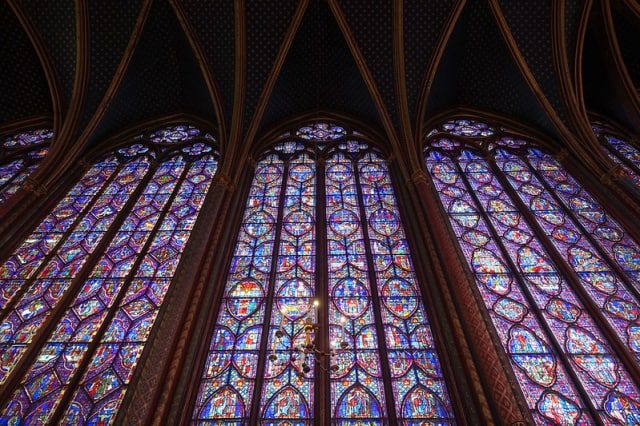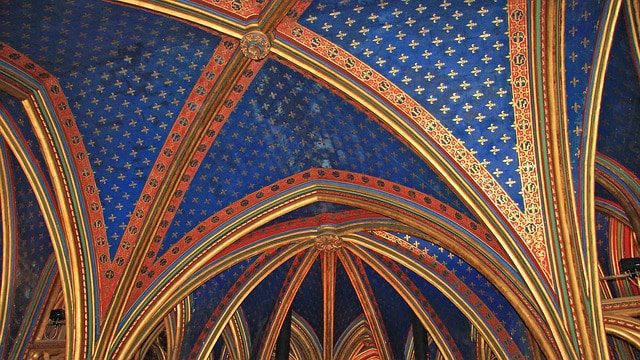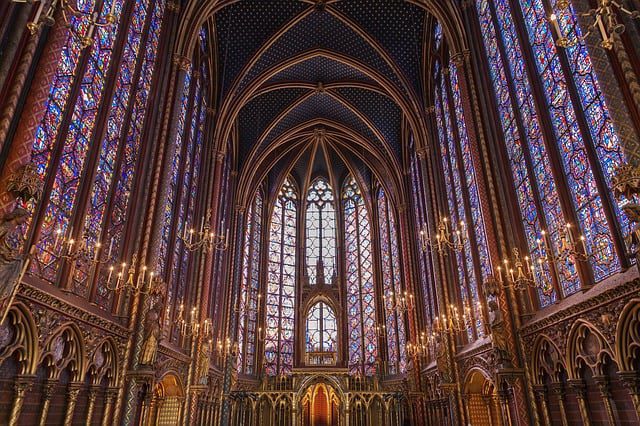Top 10 Facts about the Sainte-Chapelle
When you think of Paris, I’m going to guess that the Notre-Dame probably comes to mind. But, what about the other stunning churches in the city? The Sacré Coeur in Montmartre, the Madeleine…and (I hope), the Sainte-Chapelle!
If you’re scratching your head at the mention of the Sainte-Chapelle, you’ve come to the right place. This Parisian monument is slightly lesser known than the major ones like the Eiffel Tower or the Arc de Triomphe, but that doesn’t make it any less interesting.
Keep reading to learn more about the top 10 facts about the Sainte-Chapelle in Paris!
Practical Information
Entry fee: 10 euros
Opening hours: Open every day. January 2-March 31 9am-5pm, April 1-September 30 9am-7pm, October 1-December 31 9am-5pm
Address: 10 boulevard du Palais 75001 Paris
Metro: Cité
1. King Louis IX commissioned the construction of the Sainte-Chapelle
The Sainte-Chapelle was built in 1242 under the orders of King Louis IX of France. It was completed fairly quickly, and was in use by 1248. The structure isn’t a cathedral, and it’s not even really considered to be a church, it’s a chapel! In fact, Sainte-Chapelle translated to English means Holy Chapel. King Louis IX wanted to have a special royal chapel for himself and the rest of the nobility to worship in.
The chapel was built in the courtyard of the royal palace that was on the Île de la Cité at the time. Long before the French court was moved to the Louvre and Versailles, French royalty lived on the central island that is also the home to the Palais de Justice, the Conciergerie and Notre-Dame.
That’s not all: at the time, King Louis IX had his hands on 22 different religious relics! He needed somewhere special to house them, and that’s where the Sainte-Chapelle would come in.
2. The Sainte-Chapelle used to house 22 religious relics
King Louis IX was pretty passionate about collecting relics. In 1239, he purchased the Crown of Thorns and the Image of Edessa, in addition to others, from the emperor of Constantinople, Baldwin II for an impressive 135,000 livres (the currency at the time).
When the relics finally arrived in Paris, the king threw a week long party to celebrate the fact that the relics were finally in his court. King Louis IX knew he needed to build a special place to house the relics, but in the meantime he kept them in a large silver chest which was called the Grand-Chasse. No expense was spared: he spent an additional 100,000 livres on the chest.
While the Sainte-Chapelle was under construction, the relics were temporarily placed at the Château de Vincennes, and in another specially built chapel in the Château de Sainte-Germain-en-Laye.
King Louis IX apparently couldn’t get enough relics to add to his collection. In 1246, he acquired supposed fragments of the True Cross and the Holy Lance. The Sainte-Chapelle was officially consecrated on April 26, 1248, and the relics were moved to their final home. This, of course, was celebrated with another party!
King Louis IX also used to show all of his relics to church goers every Good Friday. He was really proud of his collection, apparently!
3. King Louis IX would go on to become Saint Louis
A little side note on King Louis IX, as he played a crucial part in the construction of the Sainte-Chapelle!
King Louis IX was crowned in Reims, France when he was just 12 years old in 1226. He was fairly religious throughout most of his life, but surviving a severe illness in his youth is what really cemented his faith in Christianity.
He fought in the Seventh and Eighth Crusades, he was a strict king that severely punished people who were guilty of blasphemy, prostitution and gambling. He (as you already know!) had a massive collection of relics, and after his death, he was canonized as a saint!
In 1297, Pope Boniface VIII announced that King Louis IX was to be canonized. Introducing, Saint Louis! He is the only French king ever to reach sainthood.
4. The Sainte-Chapelle is actually made up of 2 chapels
Let’s get back to the Sainte-Chapelle! And more specifically, how the structure is set up. Before I get started, do you remember how much King Louis IX spent on the relics that he needed to find a home for? In total, 235,000 livres. The cost to build the Sainte-Chapelle? Just 40,000 livres!
The chapel is actually made up of 2 chapels. The upper, was meant for the king and the royal family and the relics. The lower, was meant for common people that worked in the royal palace.
The upper chapel is, as you can imagine as it was built for royalty and relics, very impressive. It is designed in the Gothic style (more on that later), and is absolutely stunning. The ceilings are painted blue with golden fleur de lys, there is stained glass everywhere (more on that later, too!), and there are 12 statues that represent the 12 Apostles. King Louis IX definitely wanted to house his relics in a dramatic and extraordinary location. Mission accomplished!
The lower chapel is dedicated to the Virgin Mary, and is definitely a little more low key than the upper chapel. That isn’t to say it’s any less beautiful. The chapel is centered around the statue of the Virgin Mary which is in the middle of the space, and thanks to the lights shining directly on it is the focal point of the room. Here, there are 12 medallions that represent the 12 Apostles rather than statues.
5. The main feature of the Sainte-Chapelle are the stained glass windows
I’ve already briefly mentioned the stained glass windows in the Sainte-Chapelle. Well, they are the main focal point of the chapel, and are the reason why 900,000 visitors flock there each year!
The upper chapel in particular features over 600 m2 of glass. There are 15 windows in total, and they date back to the 13th century. In fact, the Sainte-Chapelle is one of the most extensive collection of 13th century stained glass in the world.
It almost feels like you’re inside of a kaleidoscope when you’re inside the Sainte-Chapelle. It’s a truly breathtaking scene that I recommend to anyone coming to Paris. More information on these windows, coming right up!
6. The stained glass in the upper chapel depicts over 1,000 biblical figures
The stained glass windows in the Sainte-Chapelle feature biblical scenes from both the Old and New Testaments from the Bible. This includes The Passion, the Infancy of Christ, and the Life of John the Evangelist.
There are also other sections that are dedicated to showing the “ideal king and queenship,” or, in other words, how to be a good Christian ruler. This shouldn’t come as a surprise, seeing how dedicated to religion King Louis IX was.
There are also scenes from the Book of Genesis, Exodus, Numbers, Judges, David and more. There are windows that depict the discovery of Christ’s relics and the miracles they were able to perform with them. Finally, there is also, of course, a window that depicts King Louis IX bringing the relics to Paris.
7. The rose stained glass window has 82 petals
The rose stained glass window does not date back to the 13th century when the Sainte-Chapelle was originally built. It was installed in the 15th century and has 82 “petals.” I know the Notre-Dame is really famous for it’s rose window, but I also really love the one in the Sainte-Chapelle as well.
The window depicts Saint John’s Book of Revelation, and is considered to have a Flamboyant Gothic style.
8. The Sainte-Chapelle is an excellent example of Gothic architecture
If you’ve been paying attention up until this point, you know that the Sainte-Chapelle is constructed in the Gothic style of architecture. Gothic architecture has a number of different interpretations, and the Sainte-Chapelle is placed in the “Rayonnant” Gothic category. Rayonnant Gothic architecture is recognizable by it’s vertical emphasis, and was popularized by the French.
From the outside, the Sainte-Chapelle is fairly reserved and simple. You won’t find any flying buttresses here.
Another unique part of the Sainte-Chapelle’s design is that there is a lot of paint on the interior walls. This is rare to see today, as paint is the first to fade with age and many churches, chapels and cathedrals are restored without it. Not the Sainte-Chapelle! I already mentioned the fleur de lys pattern you’ll see on the ceiling of the upper chapel, but that isn’t the only paint you’ll see. Historians also believe that the original colors used in the chapel were much brighter than those you see today! The Sainte-Chapelle is truly teeming with color.
9. Much of the Sainte-Chapelle was destroyed during the French Revolution
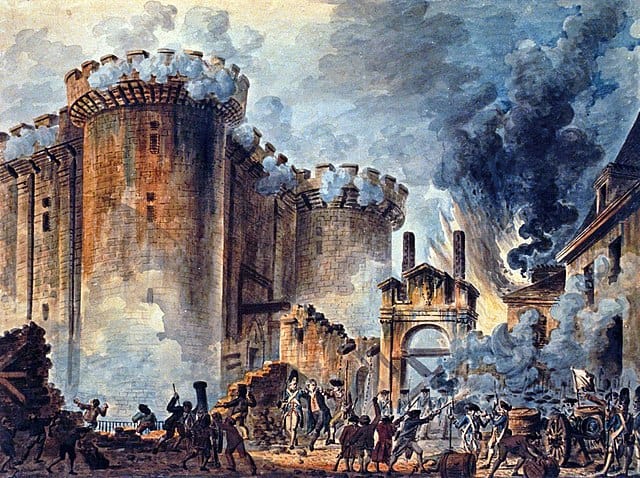
The Storming of the Bastille in Paris during the French Revolution by
Jean-Pierre Houël – WikiCommons
Like many things in Paris, much of the Sainte-Chapelle was destroyed during the French Revolution. The Revolution is famous for the decapitation of kings, queens and other nobles, but the Revolutionists also had a huge problem with the Church. This is why many churches and cathedrals were severely damaged or completely destroyed during this time.
During the French Revolution, the steeple and the baldachin (a canopy placed over an alter) were stolen, relics were also taken, and others, including the Grand-Chasse, were melted down. Some of the relics did survive, and are now held in the treasury of Notre-Dame.
In general, most of what you’ll see at the Sainte-Chapelle today is a restoration or re-creation. This is understandable, as it is so old! That being said, most of the stained glass windows have been authentically restored after a successful 19th century restoration.
10. No one knows who designed the Sainte-Chapelle
I think this is the most intriguing fact about the Sainte-Chapelle! You read that title right: no one knows who is behind the design of the Sainte-Chapelle.
There are many theories as to who is responsible, but none have ever been proven. The first, and most popular, gives credit to a man named Pierre de Montreuil. He was a master mason who is famous for his work on the Notre-Dame and the Royal Abbey of Saint-Denis.
Other more modern theories credit Jean de Chelles, Thomas de Cormont, or yet another anonymous mason that hailed from Amiens, France.
Conclusion
I hope you’ve enjoyed learning more about the Sainte-Chapelle in Paris! I know that it’s a lesser known Parisian monument, and that many people don’t even know that it exists, so I was super happy to be able to write an informative article about it. Even if you had heard of the chapel, I hope you learned something new after reading!
If you’d like to learn more about Paris and all of the impressive things to see here, why not join one of our walking tours? Our local guides really know their stuff! Click here to learn more and to make your booking.
Planning a trip to Paris ? Get ready !
These are Amazon’s best-selling travel products that you may need for coming to Paris.
Bookstore
- The best travel book : Rick Steves – Paris 2023 – Learn more here
- Fodor’s Paris 2024 – Learn more here
Travel Gear
- Venture Pal Lightweight Backpack – Learn more here
- Samsonite Winfield 2 28″ Luggage – Learn more here
- Swig Savvy’s Stainless Steel Insulated Water Bottle – Learn more here
Check Amazon’s best-seller list for the most popular travel accessories. We sometimes read this list just to find out what new travel products people are buying.



